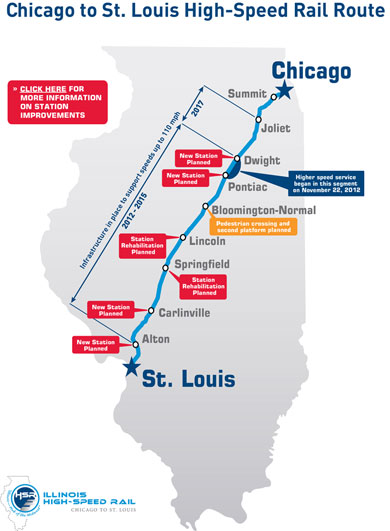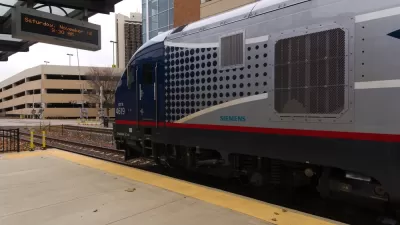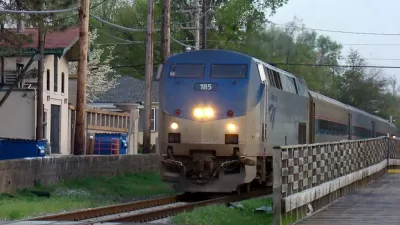Next year, trains traveling at up to 110 mph will speed through grade crossings faster than the current trains traveling at up to 79 m.p.h, and motorists need to prepare for crossing gates that will stay down up to three times longer.

It's not just a matter of the length of gate down time, but that the gates will come down "up to a minute (or) minute and a half" before the higher-speed trains arrive, meaning that motorists, pedestrians and cyclists won't be able to hear or see the oncoming train as is currently the case, states rail safety expert Mike Stead in a video accompanying The State Journal-Register article.
Consequently, road users "will have to trust that the warning system is providing them with the correct information that a train is approaching," Stead warns. Considering the number of fatalities and injuries caused by impatient drivers who knowingly break the law by driving around descended railroad gates, the longer downtimes without signs of an oncoming train may exacerbate grade crossing crashes.
To prevent motorists from even considering driving around the closed gates, quad gates will be installed, along with other safety improvements such as positive train control, illustrated in a clever Amtrak safety video.
"State transportation officials have set a goal of Amtrak speeds up to 110 mph on much of the Chicago-St. Louis corridor in 2017," reports Tim Landis.

There were 141 collisions at all Illinois rail crossings in 2015, the highest figure since 2008, according to ICC figures. Collisions with vehicles resulted in 15 deaths and 76 injuries. There were 16 pedestrian deaths and eight injuries.
In addition to quad gates, positive train control will also be in place for the faster trains.
"The system sends a signal to an operator of an oncoming train if there is a vehicle at a crossing so the operator of train can slow down and stop the train," reports Joseph Bustos for Mass Transit.
"If he or she doesn't react to the warning, the train will begin to shut down automatically to minimize and hopefully eliminate any crashes," said Scott Speegle, Passenger Rail Marketing manager for Illinois Department of Transportation (IDOT).
The trade-off for longer wait times for motorists at grade crossings are shorter trip times for those on the train. The higher-speed trains are expected to take "one hour off the train ride that now takes about 5 hours and 15 minutes," reports Bob Okon for The Herald-News.
Faster trip times will hopefully attract more riders, but unlike the roads that experience congestion with more use, more passengers will make the Chicago-St. Louis- higher-speed train service more sustainable.
When the higher-speed train service arrives next year, it will be among the first rail successes that trace back to President Obama's much-criticized 2009 Recovery Act.
Hat tip to AASHTO Daily Transportation Update.
**The 110 m.p.h. train service is referred to as "high-speed" by IDOT and media outlets which report on it, but Planetizen is more comfortable calling it "higher-speed."
FULL STORY: Crossing technology a sign of faster trains to come

Planetizen Federal Action Tracker
A weekly monitor of how Trump’s orders and actions are impacting planners and planning in America.

Map: Where Senate Republicans Want to Sell Your Public Lands
For public land advocates, the Senate Republicans’ proposal to sell millions of acres of public land in the West is “the biggest fight of their careers.”

Restaurant Patios Were a Pandemic Win — Why Were They so Hard to Keep?
Social distancing requirements and changes in travel patterns prompted cities to pilot new uses for street and sidewalk space. Then it got complicated.

Platform Pilsner: Vancouver Transit Agency Releases... a Beer?
TransLink will receive a portion of every sale of the four-pack.

Toronto Weighs Cheaper Transit, Parking Hikes for Major Events
Special event rates would take effect during large festivals, sports games and concerts to ‘discourage driving, manage congestion and free up space for transit.”

Berlin to Consider Car-Free Zone Larger Than Manhattan
The area bound by the 22-mile Ringbahn would still allow 12 uses of a private automobile per year per person, and several other exemptions.
Urban Design for Planners 1: Software Tools
This six-course series explores essential urban design concepts using open source software and equips planners with the tools they need to participate fully in the urban design process.
Planning for Universal Design
Learn the tools for implementing Universal Design in planning regulations.
Heyer Gruel & Associates PA
JM Goldson LLC
Custer County Colorado
City of Camden Redevelopment Agency
City of Astoria
Transportation Research & Education Center (TREC) at Portland State University
Camden Redevelopment Agency
City of Claremont
Municipality of Princeton (NJ)




























